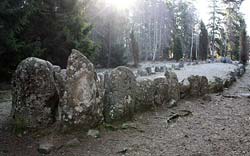Stone ships show signs of maritime network in Baltic Sea region 3000 years ago

"The stone ships can be found across the entire Baltic Sea region and especially on the larger islands, with a significant cluster on the Swedish island of Gotland. Photo: Joakim Wehlin, University of Gothenburg."<br>
The maritime groups were part of a network that extended across large parts of northern Europe. The network was maintained largely because of the strong dependence on bronze.
Archaeologists have long assumed that bronze was imported to Scandinavia from the south, and recent analyses have been able to confirm this notion. The distribution of bronze objects has been discussed frequently, with most analyses focusing on the links in the networks. The people behind the networks, however, are only rarely addressed, not to mention their meeting places.
‘One reason why the meeting places of the Bronze Age are not discussed very often is that we haven’t been able to find them. This is in strong contrast to the trading places of the Viking Age, which have been easy to locate as they left behind such rich archaeological material,’ says the author of the thesis Joakim Wehlin from the University of Gothenburg and Gotland University.
In his thesis, Wehlin has analysed the archaeological material from the Bronze Age stone ships and their placement in the landscape. The stone ships can be found across the entire Baltic Sea region and especially on the larger islands, with a significant cluster on the Swedish island of Gotland. The ships have long been thought to have served as graves for one or several individuals, and have for this reason often been viewed as death ships intended to take the deceased to the afterlife.
‘My study shows a different picture. It seems like the whole body was typically not buried in the ship, and some stone ships don’t even have graves in them. Instead, they sometimes show remains of other types of activities. So with the absence of the dead, the traces of the survivors tend to appear.’
One of Wehlin’s conclusions is that the stone ships and the activities that took place there point to people who were strongly focused on maritime practice. Details in the ships indicate that they were built to represent real ships. Wehlin says that the stone ships give clues about the ship-building techniques of the time and therefore about the ships that sailed on the Baltic Sea during the Bronze Age.
By studying the landscape, Wehlin has managed to locate a number of meeting places, or early ports.
‘These consist of areas that resemble hill forts and are located near easily accessible points in the landscape – that is, near well-known waterways leading inland. While these areas have previously been thought to be much younger, recent age determinations have dated them to the Bronze Age.’
The thesis offers a very extensive account of the stone ships. It also suggests that the importance of the Baltic Sea during the Scandinavian Bronze Age, not least as a waterway, has been underestimated in previous research.
Contact:
Joakim Wehlin,
phone: +46 (0)703-469776,
e-mail: joakim.wehlin@archaeology.gu.se
Media Contact
More Information:
http://www.gu.seAll latest news from the category: Earth Sciences
Earth Sciences (also referred to as Geosciences), which deals with basic issues surrounding our planet, plays a vital role in the area of energy and raw materials supply.
Earth Sciences comprises subjects such as geology, geography, geological informatics, paleontology, mineralogy, petrography, crystallography, geophysics, geodesy, glaciology, cartography, photogrammetry, meteorology and seismology, early-warning systems, earthquake research and polar research.
Newest articles

Superradiant atoms could push the boundaries of how precisely time can be measured
Superradiant atoms can help us measure time more precisely than ever. In a new study, researchers from the University of Copenhagen present a new method for measuring the time interval,…

Ion thermoelectric conversion devices for near room temperature
The electrode sheet of the thermoelectric device consists of ionic hydrogel, which is sandwiched between the electrodes to form, and the Prussian blue on the electrode undergoes a redox reaction…

Zap Energy achieves 37-million-degree temperatures in a compact device
New publication reports record electron temperatures for a small-scale, sheared-flow-stabilized Z-pinch fusion device. In the nine decades since humans first produced fusion reactions, only a few fusion technologies have demonstrated…





















